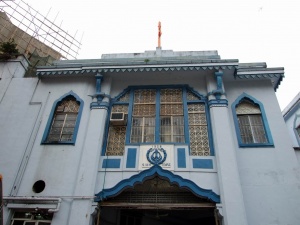Khalsa Diwan Sikh Temple: Difference between revisions
Hari singh (talk | contribs) No edit summary |
Hari singh (talk | contribs) No edit summary |
||
| Line 1: | Line 1: | ||
[[File:HK SikhTemple 1938 Bldg.jpg|right|thumb|The Khalsa Diwan Sikh Temple]] | |||
'''Khalsa Diwan Sikh Temple''' is a gurdwara in the Wan Chai District of Hong Kong, on the junction of Queen's Road East and Stubbs Road, Hong Kong Island. | '''Khalsa Diwan Sikh Temple''' is a gurdwara in the Wan Chai District of Hong Kong, on the junction of Queen's Road East and Stubbs Road, Hong Kong Island. | ||
==History== | ==History== | ||
The Gurdwara was built in 1901 by local Sikhs, including Sikhs soldiers from the British Army. This holy shrine functions in its role of providing religious, social, practical and cohesive support to generations of Sikhs in Hong Kong and continues to do so. It is also the center of Sikh community activities. The need for a proper Gurdwara was evident in the early days of Hong Kong and the government allocated land at Happy Valley for the building of the Gurdwara. | |||
Many Sikhs on their way to immigrate to Canada, in what later became the [[Komagata Maru|Komagata Maru incident]], slept in the Gurdwara and prayed there before boarding the ship in 1914.<ref>{{cite web|url=http://www.sikhpioneers.org/s_komaphot.html|title=Pioneer Sikh East Indian Immigration to the Pacifc Coast from the Punjab|publisher=Sikh Pioneers|accessdate=6 July 2013}}</ref> In the 1930s, with an increase in the size of the local Sikh community, the Gurudwara was extended and rebuilt. | |||
In the early 1940s, during World War II, the Gurdwara was bombed twice, sustaining extensive damage. The then Gurudwara Granthi (priest), Bhai Nand Singh, was sitting in the main hall reading the Sri Guru Granth Sahib (the Sikh holy scripture) when he was fatally injured in one of the attacks. However, the [[Guru Granth Sahib]] was not damaged. Many Sikhs and Non-Sikhs had sought refuge in the Gurdwara during the attack and some of them also sustained injuries. | |||
After the war, the damaged areas of the Gurdwara were rebuilt by the Sikhs with help from Non-Sikhs as well including assistance of [[Sindhi people|Sindhi]] Hindus. The Gurdwara was again extended in the 1980s, and linked to Queens’ Road East by a covered bridge, which provides easy access for the devotees.<ref name="khalsa">{{cite web|url=http://www.khalsadiwan.com/about.htm|title=KHALSA DIWAN (HONG KONG)|publisher=Khalsa Diwan Sikh Temple|accessdate=6 July 2013}}</ref> | |||
==Role of the Temple in Hong Kong== | ==Role of the Temple in Hong Kong== | ||
| Line 16: | Line 19: | ||
* [http://www.khalsadiwan.com/ ''Official website''] | * [http://www.khalsadiwan.com/ ''Official website''] | ||
* [http://www.flickr.com/photos/jbhangoo/2776063434/ Photos of Gurdwara on Flickr] | * [http://www.flickr.com/photos/jbhangoo/2776063434/ Photos of Gurdwara on Flickr] | ||
==References== | |||
{{reflist}} | |||
Revision as of 20:29, 9 February 2014
Khalsa Diwan Sikh Temple is a gurdwara in the Wan Chai District of Hong Kong, on the junction of Queen's Road East and Stubbs Road, Hong Kong Island.
History
The Gurdwara was built in 1901 by local Sikhs, including Sikhs soldiers from the British Army. This holy shrine functions in its role of providing religious, social, practical and cohesive support to generations of Sikhs in Hong Kong and continues to do so. It is also the center of Sikh community activities. The need for a proper Gurdwara was evident in the early days of Hong Kong and the government allocated land at Happy Valley for the building of the Gurdwara.
Many Sikhs on their way to immigrate to Canada, in what later became the Komagata Maru incident, slept in the Gurdwara and prayed there before boarding the ship in 1914.[1] In the 1930s, with an increase in the size of the local Sikh community, the Gurudwara was extended and rebuilt.
In the early 1940s, during World War II, the Gurdwara was bombed twice, sustaining extensive damage. The then Gurudwara Granthi (priest), Bhai Nand Singh, was sitting in the main hall reading the Sri Guru Granth Sahib (the Sikh holy scripture) when he was fatally injured in one of the attacks. However, the Guru Granth Sahib was not damaged. Many Sikhs and Non-Sikhs had sought refuge in the Gurdwara during the attack and some of them also sustained injuries.
After the war, the damaged areas of the Gurdwara were rebuilt by the Sikhs with help from Non-Sikhs as well including assistance of Sindhi Hindus. The Gurdwara was again extended in the 1980s, and linked to Queens’ Road East by a covered bridge, which provides easy access for the devotees.[2]
Role of the Temple in Hong Kong
Since 1841, the size of the Sikh community from the Punjab has grown along with Hong Kong from its infancy as a small fishing port to its present status as a world-class cosmopolitan city. The Gurdwara has co-existed peacefully and harmoniously with the local Chinese community for over a century. Sikhs have participated effectively in the development of Hong Kong and contributed actively to the society of Hong Kong. Sikhs were the first constables of the Hong Kong Police Force in 1844. They also served as civil servants, administration officers, officers of the disciplined forces, professionals, security guards, and in other essential services. Khalsa Diwan Hong Kong having witnessed struggles, war, development, political and social changes continues to perform its traditional functions dutifully by contributing to the religious needs and well being of Sikhs in Hong Kong.
External links
References
- ^ Pioneer Sikh East Indian Immigration to the Pacifc Coast from the Punjab http://www.sikhpioneers.org/s_komaphot.html Sikh Pioneers Retrieved 6 July 2013
- ^ KHALSA DIWAN (HONG KONG) http://www.khalsadiwan.com/about.htm Khalsa Diwan Sikh Temple Retrieved 6 July 2013

